The collaboration between Airbus and VDL includes the development of a demonstration model and prototype of UltraAir.
Airbus and VDL Groep will collaborate in the development and production of so-called laser communication terminals for aircraft, called UltraAir. A start is made with the development and production of a prototype. A first test flight is planned for 2024. This builds on the development initiated by the aerospace company Airbus and research organization TNO.
The UltraAir equipment makes it possible to exchange large amounts of data using laser connections, in a network of ground stations and satellites orbiting 36.000 kilometers above the earth. With advanced technology, including a highly stable and accurate opto-mechatronic system, laser communication terminals enable transmission speeds of gigabits per second while minimizing interference and minimizing the likelihood of interceptions.
connection
In this way, UltraAir enables military aircraft and unmanned aerial vehicles to connect, using laser-based satellite constellations, such as Airbus' so-called SpaceDataHighway network. In Airbus' strategy to further develop laser communication, this is an important step that makes the distinctive benefits of multidisciplinary collaboration visible to government and defense customers. In the longer term, UltraAir could also be used in commercial aircraft to enable passengers to establish high-speed data connections.
revolution
As a solution for data traffic in the quantum age, laser communication technology is the next revolution in satellite communication (satcom). The growing demand for satellite services is reaching the limits of the capacity of traditional radio frequencies for satellite communications. However, laser satellite communication makes it possible to process a thousand times as much data, a factor of 10 faster than via the current network. Laser connections also offer the advantage that they suffer little from interference and possible detection. Unlike the already crowded radio frequencies, laser communications are difficult to intercept because the beam is narrower. Laser satellite terminals are therefore more compact and lighter, consume less energy and are safer than radio connections.
The collaboration between Airbus and VDL includes the development of a demonstration model and prototype of UltraAir, as well as the necessary follow-up steps to produce UltraAir in volume. VDL ETG Almelo will take care of the production and will also supply critical systems, among other things. Airbus will then market UltraAir.
“As a high-tech supplier and partner for companies in the semiconductor industry in particular, we see a lot of added value in tackling the challenges of this project for Airbus. In order to produce these complex terminals, which will be equipped with mirrors and motors, as well as mechatronics and optics, in volume, we will be closely involved in the development of the technology from the start. Here, for example, we apply our system architecture and design competencies. Naturally, we work closely with other partners, such as Demcon and TNO.”
Sander Verschoor - director VDL ETG Almelo
Investments
Airbus and VDL Groep will take further steps in 2024 for the industrialization of the prototype to prepare the laser communication terminal for integration with an aircraft. A test flight of the industrialized prototype on an aircraft is planned for 2025. The development of UltraAir is made possible by investments from Airbus and VDL Groep and is supported by the ESA ScyLight (Secure and Laser Communication Technology) program and by the Growth Fund proposal NxtGen that has been awarded. High tech, led by TNO and a group of Dutch companies.



